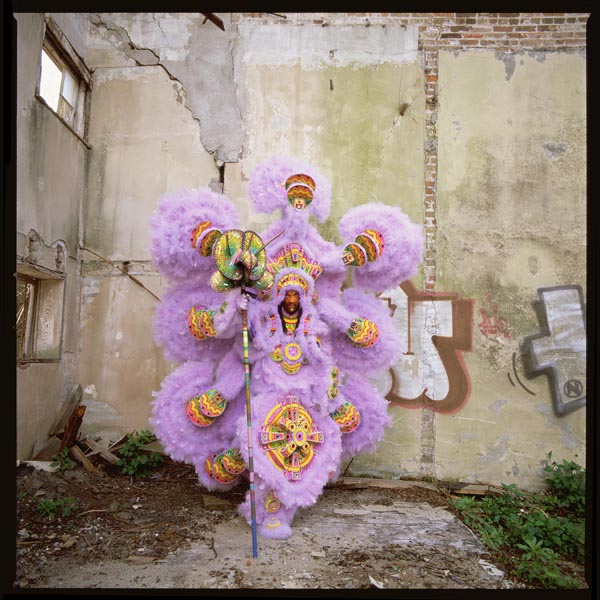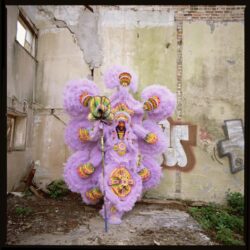Mardi Gras Indians
Mardi Gras Indians have become recognizable symbols of New Orleans's unique local culture, yet remain closely tied to their specific communities and traditions.

Courtesy of Eric Waters
Darryl Montana. Waters, Eric (photographer)
Mardi Gras Indians are African Americans who form “tribes” that hold weekly practices in bars throughout New Orleans and then march through the streets on Mardi Gras Day and other recurring dates, when they wear elaborately hand-beaded and feathered costumes known as “suits.” In these public ceremonies, the Indians sing chants as they travel in search of rival tribes. When two tribes meet, the chiefs ritualistically compete with one another by shouting boasts and insults and displaying their individually styled suits. The Mardi Gras Indians, their suits, and their songs have all become recognizable symbols of New Orleans’s unique vernacular culture. Yet they remain more closely tied to specific communities and neighborhoods than more accessible local traditions such as jazz, Mardi Gras krewe parades, and Creole cuisine.
The precise origins of the Mardi Gras Indians are not known and remain hotly contested. Some Indians and researchers claim that the history begins with the intermixing of blacks and Native Americans during slavery, when many runaway slaves sought refuge with Houma, Chitimacha, and other tribes living in the swamplands surrounding New Orleans. Others have linked the first accounts of blacks masking as Indians to the visit of Buffalo Bill’s West Show to New Orleans in 1884–85. It is also unclear whether there is a direct relationship between the Mardi Gras Indian tradition and other ceremonial and musical masquerading traditions among African diasporic communities, such as the junkanoo parades throughout the Caribbean. However the Mardi Gras Indians emerged, the significance of the Indian warrior fighting clearly had a powerful resonance among former slaves and their descendents who were subject to Jim Crow laws.
Membership in a Mardi Gras Indian tribe is voluntary and based on social networking rather than birthright. Tribes are organized with very specific roles for each member, following a system begun by early tribes such as the Creole Wild West and Yellow Pocahontas. The big chief is the tribal leader, often assisted by second chiefs and queens. The spy boy marches several blocks in front of the chiefs and queens, seeking out other tribes. He relays directions to the flag boy, who notifies the chief by waving a flag or stick. When tribes meet, the wild man clears a path among the onlookers so the chiefs can face off. Changes in the tribe membership often lead to changes in these positions, but the hierarchy of the tribal organization—akin to a military unit—is strictly maintained. Matters of any significance fall under the authority of the chief.
Fraternity within the tribe and competitiveness with other tribes characterize Mardi Gras Indian culture. The Indian embodies a particularly masculine representation of fierceness that has historically relegated women to supporting roles; there are few queens, and men virtually always fill the other ranks. In this way, the big chief and other tribe members correspond both to the figure of the Native American who “won’t bow, won’t kneel” in the face of adversity, as well as the protagonists of African-American songs and stories of “big men” such as John Henry and “bad men” such as Stagger Lee.
Historically, the fierceness of the Mardi Gras Indian was tested through violent encounters between rival tribes from the Uptown and Downtown districts at a location referred to as “the battlefield.” These clashes, called “humbugs,” dissipated greatly during the latter half of the twentieth century, partly because of increasing pressure by local police and partly because certain chiefs, most notably Allison “Tootie” Montana of the Yellow Pocahontas, redirected the competitive nature of Indian showdowns away from violent confrontation and toward pageantry (i.e., the suits, language, and songs of the Indians).
The suits of the Mardi Gras Indians are the most celebrated aspect of the culture. Every Indian sews a new suit to be unveiled on Mardi Gras morning, which requires a staggering investment of time and money, as well as the creative ability to sew feathers and beads in unique patterns and distinctive color schemes in a way that expresses the individuality of the chief and his tribe. As Indian suits have become increasingly elaborate, they have also become identifiable according to two dominant styles, divided by the bifurcation of New Orleans: The uptown style uses beaded panels to tell a story with images (such as a Native American using a tomahawk to break a slave’s chains), while the downtown style uses three-dimensional geometric designs (such as the headdress of an Egyptian pharaoh). These and other styles are prevalent among tribes located throughout the city; they are not bound by strict rules because the central aspect of the tradition is to reinvent itself in the form of a new and innovative suit every year.
The language of the Mardi Gras Indians is the most elusive and mysterious aspect of the culture. Made up of English and French as well as invented words, the speaking and singing of the Indians is a form of verbal art that resists precise translation but is widely understood by Indians. In many Indian songs, “hoo na nae” is synonymous with the phrase “let’s go get ‘em,” while the meaning of the frequently heard refrain “tuway pockyway” is entirely dependent on the context.
The songs of the Mardi Gras Indians are the most popular and accessible aspect of the culture. At Indian gatherings, songs are arranged in call-and-response fashion, with the chief improvising a solo vocal and the tribe responding with a repeated chant: “shallow water oh mama!” “big chief got a golden crown!” A “second line” (an informal parade) of percussionists accompanies the chants with tambourines, cowbells, and found objects such as beer bottles. Popular chants have also become the basis for rhythm and blues, soul, funk, and hip-hop recordings, including James “Sugarboy” Crawford’s 1954 rhythm and blues recording of “Jock-A-Mo.” Renamed “Iko Iko,” the song became a national hit eleven years later, performed by the Dixie Cups. The music and spectacle of the Indians has also spawned tribute songs, such as Earl King’s “Big Chief,” popularized by pianist Professor Longhair in a 1964 recording.
In 1971, Bo Dollis and the Wild Magnolias were the first Indians to make a commercial recording of their own music, using a group of funk musicians to arrange Dollis’s “Handa Wanda.” Under the musical direction of pianist, composer, and arranger Wilson Turbinton (“Willie Tee”), the Wild Magnolias recorded two LPs in the early 1970s and toured the United States and France. Indian funk was given a sizable boost in 1976 when the Wild Tchoupitoulas tribe recorded an album, titled Wild Tchoupitoulas, with arrangements by the city’s most acclaimed funk group, The Meters. On the record and in performance at the New Orleans Jazz & Heritage Festival, lead vocalist Joseph Landry (“Chief Jolly”) was accompanied by his nephews, the Neville Brothers. Like Willie Tee, the Nevilles—Art, Charles, Aaron, and Cyril Neville—grew up listening to the Indians on Mardi Gras Day. Music composed for these recordings, such as the Magnolias’ “New Suit” in 1975 and the Tchoupitoulas’ “Meet De Boys on the Battlefront,” released the next year, now stand alongside “Big Chief” and “Iko, Iko” as the most prominent and durable signs of the Mardi Gras Indian tradition.
Musical recordings and staged performances brought extraordinary recognition to what had been a relatively obscure and even secretive community practice, attracting a much larger public to the tradition of masking and chanting. The increased attendance at Indian parades on Mardi Gras Day and especially the proliferation of official cultural presentations—museum exhibitions of costumes, Indian parades at local festivals, concert performances of traditional chanting—owe much to the ongoing popularity of Indian music.
Mardi Gras Indians are a prominent and vital thread in the tapestry of local culture. Once seen only on Mardi Gras day and St. Joseph’s Day night by a select few, today the Indian has become a fixture at events all over the city and throughout the year. “Super Sunday” has become a popular springtime outing for a diverse crowd of spectators who come to see the tribes in three neighborhoods: Uptown, Downtown, and the West Bank. At the New Orleans Jazz & Heritage Festival, tribes parade through the fairgrounds and appear onstage. Chiefs such as musician Donald Harrison Jr. and the late plasterer, Tootie Montana, became respected public figures and voices of the community through their Indian-related activities. And new tribes have continued to form even after the devastation of Hurricane Katrina, demonstrating the vitality of this cherished local tradition.
